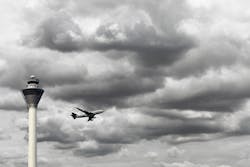Sagetech: Inexpensive COTS equipment can enhance the safety, usefulness of drones in civil, defense missions
WHITE SALMON, Wash., 7 Nov. 2012. One major benefit of the NextGen ADS-B system is that the equipment required to send and receive aircraft position reports can be inexpensive, says a representative of Sagetech, an avionics company in White Salmon, Wash.
“Small ADS-B data receivers are available, enabling surrounding ADS-B Out equipped aircraft to be displayed using increasingly popular electronic flight bag apps running on Apple iPads.
“Pilots of manned aircraft have difficulty visually detecting drones because they are generally small and hard to see. The ADS-B Out system can simplify locating other aircraft by providing pilots and operators real-time overlays of aircraft location, making visual detection less important in the task of assuring separation and collision avoidance,” Sagetech’s spokesperson adds.
“Drone operations can be enhanced without penalizing manned aircraft by further restricting airspace. Using inexpensive equipment, such as iPads, that are already finding use in general aviation cockpits and by operators, range personnel, and others, can readily track unmanned aircraft. We do not suggest this is a complete Sense and Avoid solution that allows for broad use of drones in the civil airspace. Rather, this demonstration is intended to spark ideas and nurture creative approaches to how we can take small steps toward combined unmanned/manned operations.
“Applications where this unique combination can be used to enhance the usefulness of UAV missions are numerous. Military ranges can now track use of their airspace by guest organizations simply by adding a small transponder brick weighing only a few ounces that enables Range Control personnel to track guest drones using stand-alone, independent systems.
Forest fire areas of operation, in which TFRs (Temporary Flight Restrictions) restrict aircraft, can now replace expensive helicopters with drones that will help manage ground-based and aircraft firefighting strategies and monitor their effectiveness. Flight crews and ground personnel can be issued easy to use iPads and ADS-B receivers, allowing pilots to monitor locations of drones, and ground personnel to see the locations of all aircraft as firefighting operations progress, increasing safety and situational awareness.
“Law enforcement and border patrol organizations have become early adopters among civil users of unmanned aircraft. Use of drones by law enforcement is presently limited, with line-of-sight control of small quad-rotor hover vehicles offering only marginally more capability than simple aircraft long used by R/C (radio control) hobby enthusiasts. Customs and Border Patrol are using more capable aircraft and operate nine Predator drones as of this writing. The Department of Defense is the primary force behind drone popularization, and they themselves have need for increased access to airspace for training.
“Meanwhile, the FAA has been busy upgrading the way Air Traffic Control locates airplanes, adding the NextGen ADS-B system infrastructure to their existing legacy radar systems. The ADS-B system is a world standard inspired by the success of a similar maritime system allowing ships to electronically track one another to avoid collision.
“The NextGen concept is simple. Aircraft transmit GPS position and fight information reports by way of ADS-B Out messages. ADS-B Out capability will be required of virtually all aircraft in the US by Jan 1, 2020. Europe, Australia, and the world in general are also adopting ADS-B Out requirements.
“ADS-B receivers allow pilots to access free in-flight weather data broadcast from FAA ADS-B ground stations, a service previously available only by paid subscription to Sirius Satellite Radio. Some of these ADS-B receivers, like Sagetech’s Clarity, are capable of receiving ADS-B Out position reports.
“Drone and manned aircraft alike can be tracked anywhere within an operations area up to 100 miles in diameter using inexpensive equipment:
- Small transponders on drones and manned aircraft
- iPads and EFB apps for pilots and ground personnel
- Portable low cost ADS-B receivers
“These facilitate the ability for UAV operators and pilots to self-deconflict flight paths.”
Follow Avionics Intelligence news updates on Twitter (@Avionics_Intel), LinkedIn, and Google+.
ATC image courtesy Shutterstock.


